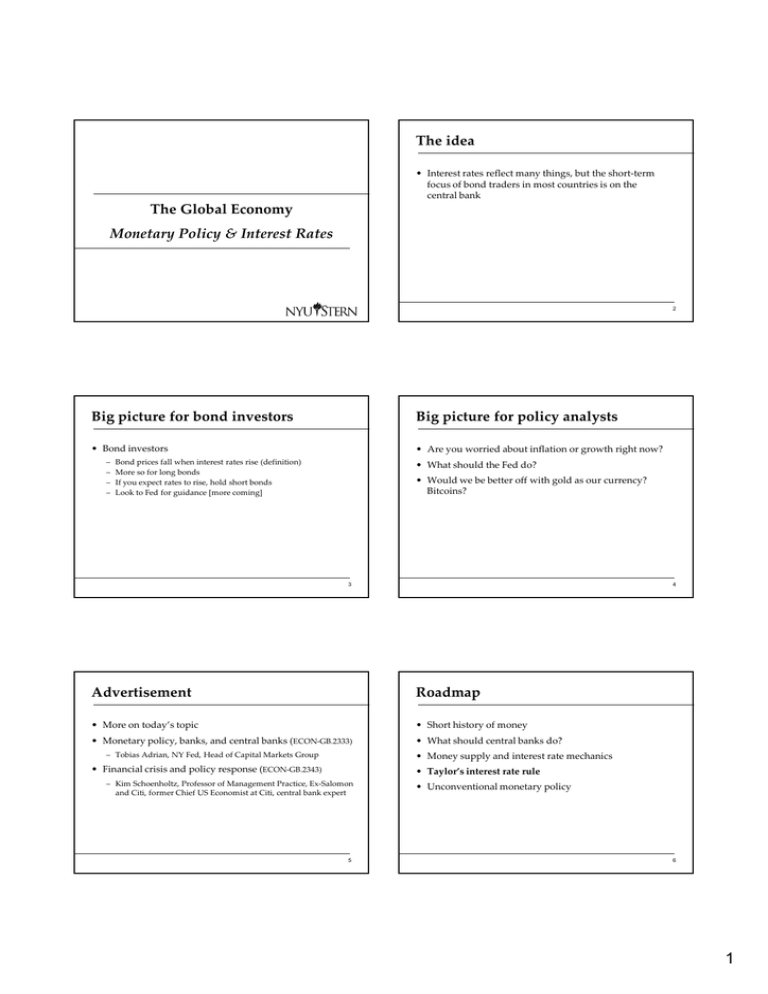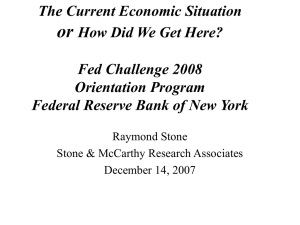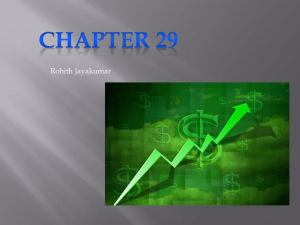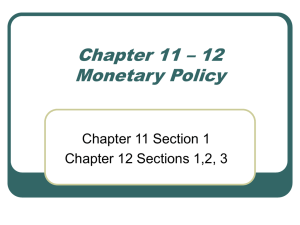
The idea
• Interest rates reflect many things, but the short-term
focus of bond traders in most countries is on the
central bank
The Global Economy
Monetary Policy & Interest Rates
2
Big picture for bond investors
Big picture for policy analysts
• Bond investors
• Are you worried about inflation or growth right now?
–
–
–
–
Bond prices fall when interest rates rise (definition)
More so for long bonds
If you expect rates to rise, hold short bonds
Look to Fed for guidance [more coming]
• What should the Fed do?
• Would we be better off with gold as our currency?
Bitcoins?
3
4
Advertisement
Roadmap
• More on today’s topic
• Short history of money
• Monetary policy, banks, and central banks (ECON-GB.2333)
• What should central banks do?
– Tobias Adrian, NY Fed, Head of Capital Markets Group
• Money supply and interest rate mechanics
• Financial crisis and policy response (ECON-GB.2343)
• Taylor’s interest rate rule
– Kim Schoenholtz, Professor of Management Practice, Ex-Salomon
and Citi, former Chief US Economist at Citi, central bank expert
5
• Unconventional monetary policy
6
1
Stone money
• Milton Friedman, “Stone money,” in Money Mischief
– On the island of Yap in the Western Pacific …
• What’s the point?
Short history of money
8
Commodity money
Commodity money
• Gold standard
• David Ricardo, Proposals for a Secure Currency, 1816
– Money tied to gold (eg, 1 oz = $35)
– In principle, people can take their money to the central bank
and exchange it for gold
– The introduction of precious metals [as money] may with
truth be considered one of the most important steps toward
the improvement of commerce. But it is no less true that … it
would be another improvement to banish them altogether [in
favor of paper money].
– This guarantees money has value
• Questions
• What is he saying? Do you agree?
– Does it deliver stable prices?
– Is it a waste of gold?
– An improvement on our current system?
9
Prices with commodity & paper monies
10
Open question
• How do we deliver stable prices?
– Commodity money?
– Central bank policy?
– Something else?
11
12
2
Federal Reserve System
• Founded by Federal Reserve Act of 1913
– The Federal Reserve System and the Federal Open Market
Committee should seek “to promote effectively the goals of
maximum employment, stable prices, and moderate longterm interest rates.”
What should central banks do?
• So what’s the goal?
• And what about motherhood and apple pie?
14
ECB
Federal Reserve revisited
• ECB = European Central Bank
• Ben Bernanke, testimony before Congress, November
2005
• Treaty of Maastricht (1992)
– The primary objective of [monetary policy] shall be to
maintain price stability.
– Without prejudice to the objective of price stability, the ECB
shall support the general economic policies in the Community
with a view to contributing to the achievement of … a high level
of employment and sustainable and non-inflationary growth.
– Middle income living standards and poverty are best
addressed through employment growth. By maintaining low
inflation and low expectations of inflation, you can create new
employment.
• Does this make sense to you? Or should we eliminate
the “dual mandate”?
• How does this differ from Fed? Why? Good idea or
bad?
15
16
Banco Central de Argentina
• BCRA Act of 2003
– The Argentine Central Bank is a self-governed institution
whose primary and fundamental mission is to preserve the
value of the currency.
Money & interest rates
• Good idea? Did it work?
17
3
Where do interest rates come from?
Where do interest rates come from?
• Short-term?
• Long-term?
• Nominal?
• Real?
• Other?
19
Where do interest rates come from?
20
Where do interest rates come from?
21
Where do interest rates come from?
22
Where do interest rates come from?
• Interest and inflation (“Fisher equation”)
i = r+π
– i = “nominal” interest rate (payment in dollars)
– r = “real” interest rate (payments in goods)
– π = inflation (expected?)
23
24
4
Overview
• Central banks shift AD by changing money supply
• Our approach
– Increase in interest rate is same as reduction in money supply
– Decrease in interest rate is same as expansion of money supply
Money supply & interest rate mechanics
• More soon, but that’s the point
• Focus on US, but [most] other countries are similar
26
The market for reserves
Money supply mechanics
• Reserves are deposits of banks at Fed (“fed funds”)
• More detail than previous version
– Reserves held by banks against deposits
– The Fed is the bank for banks
• The Fed buys and sells government securities
– If buy, they credit reserve positions of banks
• Banks trade overnight positions in “fed funds”
– If sell, they debit reserve positions of banks
– Banks then trade among themselves in fed funds market
– If they have too much, they sell
– An overall increase in reserves supports expansion of bank
deposits (a broader version of money than currency)
– If they have too little, they buy
• The rate on these positions is the “fed funds rate”
• More detail than we need, but
– Central banks deal with financial institutions, not individuals
28
27
The Fed’s interest rate target
The Fed’s interest rate target
• Federal Open Market Committee (“Fed” or “FOMC”)
meets 8 times a year
• Statement of March 20, 2013:
• Typically announce interest rate target (fed funds) right
after the meeting
• Recent policy has included statements about asset
purchases (“quantitative easing”) – why?
– Information received since January suggests a return to
moderate economic growth. Labor market conditions have
shown signs of improvement. Household spending and
business fixed investment advanced. Inflation has been
running somewhat below the Committee's longer-run objective
[and] longer-term inflation expectations have remained stable.
– Committee decided to continue purchasing additional agency
mortgage-backed securities and longer-term Treasury
securities and to keep the target range for the federal funds
rate at 0 to 1/4 percent.
• What are they saying?
29
30
5
Hitting the target rate
The market for reserves
Federal
Funds Rate
• Banks typically hold more reserves if the rate is low
– Higher rate, better return on selling
S1
• Fed sets “fed funds rate” by changing supply of reserves
– They vary supply to hit the rate they want
i
Demand for reserves
(from banks)
Quantity of
Reserves
32
31
Hitting the target rate
Federal
Funds Rate
Hitting the target rate
Federal
Funds Rate
S1
Target
S1
i FF
i FF
i
Demand for reserves
(from banks)
Off Target!
(FF rate too low)
Demand for reserves
(from banks)
Quantity of
Reserves
Quantity of
Reserves
33
Hitting the target rate
34
Hitting the target rate
9.0
Federal
Funds Rate
S2
S1
Sell bonds for
reserves, shifting
supply
Market federal funds rate
8.0
7.0
6.0
i
rate (%)
Back to target!
FF
i
5.0
4.0
3.0
Demand for reserves
(from banks)
2.0
1.0
Quantity of
Reserves
0.0
Jan-93
35
Oct-95
Jul-98
Apr-01
Jan-04
Oct-06
Jul-09
36
6
Hitting the target rate
Up next
• Summary
• What rate do we choose?
– Increasing money supply lowers interest rate
– Could go back to AS/AD
– Decreasing money supply raises interest rate
– But there’s a useful rule of thumb that we’ll use instead
– We’ll talk as if changing money supply and interest rate are
equivalent
37
38
The Taylor rule
• A formula for setting fed funds rate
• What’s good about a formula? Bad?
• What should rate respond to?
– Inflation?
The Taylor rule for the fed funds rate
– GDP and GDP growth?
– Condition of financial system?
– Exchange rate?
– Other things?
40
The Taylor rule
The Taylor rule as bond traders guide
• John Taylor’s rule for setting fed funds rate
• What happens to interest rate if
– GDP growth rises?
i = r* + π + a1(π ₋ π*) + a2(g ₋ g*)
– Inflation rises?
– i = target fed funds rate
– r* = average real interest rate [2%]
– π = inflation rate
– π* = target inflation rate [2%]
– g = GDP growth rate
– g* = average GDP growth rate [3%]
– (a1, a2) = numbers/parameters [1/2, 1/2]
41
42
7
The Taylor rule
The Taylor rule
• What does it suggest on average?
• What does it suggest now?
i = r* + π + a1(π ₋ π*) + a2(g ₋ g*)
i = r* + π + a1(π ₋ π*) + a2(g ₋ g*)
• Recent numbers
– Inflation PCE chain index: YOY Feb = 1.3%
– Inflation CPI: Mar YOY = 1.5%
– GDP growth: YOY 2012Q4 = 1.7%
43
The Taylor rule
44
US history: inflation and growth
• How much does it respond to inflation? Why?
i = r* + π + a1(π ₋ π*) + a2(g ₋ g*)
45
US history: Taylor rule
46
The Taylor rule
• What happened in 1970s?
– Rate below Taylor rule, inflation shot up
– Same as last week, where we called it too much money
• What happened in 2001?
– Rate below Taylor rule, justified or mistake?
• What happened in 2008?
– Taylor rule points to negative rate, can’t be done [more soon]
• What should we do now?
– Something for you in Problem Set #4
47
48
8
Unconventional policy 1
• What happens when fed funds rate hits zero?
– Can’t have negative interest rates, people would hold cash
instead
– ZLB: zero lower bound
Unconventional policy
• But: you can still increase reserves and money
– QE: quantitative easing
– New name for an old idea
50
Zero lower bound
Demand for reserves
Federal
(from banks)
Funds Rate
S1
Quantitative easing
Demand for reserves
Federal
(from banks)
Funds Rate
S2
S1
S2
i FF
i FF = 0
i FF = 0
Quantity of
Reserves
B
Quantity of
Reserves 52
51
Quantitative easing
A
Quantitative easing
But remember:
We started paying
interest on reserves
53
54
9
Quantitative easing
Unconventional policy 2
• Another unconventional policy: buy private assets
– CE: credit easing
• See Cleveland Fed animation
http://www.clevelandfed.org/research/Data/Credit_Easing/index.cfm
• Find
– Aid to financial system?
– Quantitative easing?
– Credit easing?
55
Credit easing
56
What have we learned?
• Central banks usually target an interest rate rather than
the money supply
– Two ways of thinking about the same thing
• Taylor rule ties interest rate to inflation and growth
– Bond trader’s guide
– Raises questions when policy differs
• When interest rate hits zero, you can still increase the
quantity of money
57
Source: Cleveland Fed.
58
Reminder
• Problem Set #4 due in two weeks
(start of class, class 11)
The Global Economy
Principles of Tax Policy
60
10
What’s happening?
What’s happening?
• Matt Yglesias on the Reinhart-Rogoff Excel error, via
Jonathan Rossman:
– This is huge. Or, rather, it won't matter but it ought to be a big
deal. You've probably heard that countries with a high debt-toGDP ratio suffer from slow economic growth. The specific
number 90 percent has been invoked frequently … thanks to a
study by Carmen Reinhardt and Kenneth Rogoff. Now three
scholars at Umass find that the Reinhart/Rogoff result is based
on … an Excel coding error.
• What do we learn from this? Is debt a problem?
Austerity?
61
Source: Herndon, Ash, and Pollin.
62
Roadmap
Starting new module
• New module: crises
• New module organized roughly around economic crises
• The ideas
• First topic: “fiscal policy” = “government finance”
• Quotations and numbers
– Government spending
• Principles of spending policy
– Tax revenue
– Debt = deferred taxes [next week]
• Principles of tax policy
63
64
The ideas
• Countries differ – a lot – in the magnitude and type of
spending, the taxes they collect, and how they manage
their debt
• Good tax systems
Quotations and numbers
– Pay for government spending
– Are transparent and simple to execute
– Apply low rates to a broad base
65
11
Quotations
Quotations
• The Economist, Survey France, Oct 26 06:
• Ivan Miklos, Deputy Prime Minister of Slovakia,
Financial Times, on corporate taxes:
– An employer who pays a worker twice the minimum wage, or
€2,400 a month, has to shell out nearly half as much again to
the state in social-security contributions; the employee, for his
part, has to hand over 22% of his pay in social-security
contributions, on top of income tax. A French pay slip
typically runs to over 40 itemised lines.
– I am convinced that the reforms of new EU member states
could serve as inspiration for the older member states as well.
One such reform is the flat tax. … We now have one of the
simplest, most transparent tax systems in the world. … And
our tax revenues have not decreased at all, partly because the
reform eliminated most of the incentives and opportunities for
tax avoidance. The new system has been particularly popular
with German companies.
• What’s going on here?
• What’s going on here?
67
68
Quotations
Quotations
• EIU, Country Commerce Report, India:
• Tom Friedman, NYT, Mar 2 10:
– Corporate tax rates have come down in recent years to fairly
reasonable levels, in keeping with the government’s aim to
widen the tax base and ensure greater compliance. But the
underground economy, with its untaxed transactions and
incomes, remains large.
– Intel’s CEO Paul Otellini: “The things that are not conducive
to investments here are [corporate] taxes and capital
equipment credits. A new semiconductor factory at world
scale built from scratch is about $4.5 billion — in the United
States. If I build that factory in almost any other country in
the world, where they have significant incentive programs, I
could save $1 billion. [We built our new plant in China] and it
wasn’t because the labor costs are lower. Yeah, the
construction costs were a little bit lower, but the cost of
operating after tax was substantially lower.”
– The system remains complicated, however, and is the subject
of frequent litigation.
• What’s going on here?
• What’s going on here?
69
70
Quotations
Quotations
• Eduardo Porter, “A tax code of politics,” NYT, April
10, 2012:
• Eduardo Porter, “A tax code of politics,” NYT, April
10, 2012 (continued):
– Our byzantine tax code is built upon a longstanding political
deal: Democrats wanted a tax scale with higher rates for
richer Americans to finance social programs for the poor and
middle class. Republicans countered by pushing for tax
exceptions, exclusions and deductions that shielded the
incomes of the rich from the taxman and reduced government
revenue.
– The richest 1 percent of Americans, who make $1.5 million
on average, pay 28 percent of their income in federal taxes.
That’s way below the top rate of 35 percent. The rest of us
also pay little. The bottom 85 percent of taxpayers have an
average federal tax rate of 12 percent. The poorest 25
percent pay less than 1 percent of their income
• What’s going on here?
– This compromise has left us with a loophole-riddled code.
• What’s going on here?
71
72
12
Government spending (% of GDP)
US federal government spending
60
Medicare, Medicaid,
Social Security
60
50
2010
2020
share of outlays (%)
50
40
30
20
40
Where the “pork” lives
!!
30
20
10
10
0
0
US
France
Japan
China
India
Brazil
D isc. N on-security
Mexico
Source: OECD fiscal database.
Social insurance and taxes
Personal tax rates
(at average wage)
60
D isc. Security
Mandatory
Interest
73
74
Personal tax rates (%, at average wage)
60
Social expenditure
(% GDP)
50
50
40
40
30
30
20
20
10
10
0
0
US
France
Germany
Sweden
Japan
Korea
US
Mexico
75
Top personal tax rates
Fra
Ger
Swe
Source: OECD. Green=direct tax. Blue=total incl soc ins payments.
Jap
Kor
Mex
76
US average tax rates by income (all taxes)
60
50
40
30
20
10
0
US
Fra
Ger
Swe
Jap
Kor
Mex
77
78
13
US tax shares by income (all taxes)
US: marginal tax rates by income
79
US: post-tax and pre-tax income
France: marginal tax rates by income
81
Source: CBO via Cochrane.
80
Source: CBO via Cochrane.
Corporate tax rates
82
Source: OECD working paper 439, “The French tax system.”
Value-added tax rates
60
20
18
50
16
14
40
12
30
10
8
20
6
4
10
2
0
0
US
Source: KPMG.
Fra
Ger
Swe
Kor
Jap
Mex
US
83
Source: Doing Business.
Fra
Jap
Chi
Ind
Bra
Mex
84
14
Government spending
• Classic argument: provide public goods
• Public goods are
– Non excludable: hard to keep non-payers from consuming
• National security, legal system, fish in the ocean
Principles of government spending
– Non rival: my consumption does not affect your consumption
• Fresh air, NY skyline, public safety
• Hard for a private firm to capture all the benefits, so
market would provide too little
86
Government spending
Government spending
• Many goods partly private, partly public
Libertarian Reluctantly Calls Fire Department
April 21, 2004 | Issue 40•16
• Individuals and countries differ on
–
–
–
–
–
–
–
–
Roads?
Security?
Education?
Sport stadiums?
Opera?
Mass transit?
Medical care?
Others?
CHEYENNE, WY—After attempting to contain a living-room
blaze started by a cigarette, card-carrying Libertarian Trent
Jacobs reluctantly called the Cheyenne Fire Department
Monday. “Although the community would do better to rely
on an efficient, free-market fire-fighting service, the fact is
that expensive, unnecessary public fire departments do
exist,” Jacobs said. “Also, my house was burning down.”
Jacobs did not offer to pay firefighters for their service.
© Copyright 2006, Onion, Inc. All rights reserved.
The Onion is not intended for readers under 18 years of age.
87
88
Tax principles
• Societies choose different levels of spending
• They have to pay for it, primarily through taxes
• Which taxes?
Principles of tax policy
• Principles of good tax policy
1.
Collect enough revenue to pay for government spending
[next week]
2.
Are transparent and simple to execute
3.
Apply low rates to a broad base
90
15
Complexity of business taxes (hours)
Tax complexity: Vodaphone in India
• Civitas.in online case [my summary]
1000
600
– Vodafone BV, based in the Netherlands and controlled by
Vodafone UK, obtained a controlling interest in CGP
Investments Holdings, located in Cayman Island, from Hong
Kong-based Hutchinson Telecommunications International Ltd
(HTIL)
500
– HTIL had a stake in CGP’s mobile operations in India.
400
– India sent Vodaphone a $2.3b tax bill based on capital gains in
its India operations (gains taxed on transfer of control)
900
800
700
300
– The Supreme Court rejected the government’s argument in
March, but the government threatened to pass legislation
allowing retrospective taxation of business deals.
200
100
0
US
Fra
Jap
Chi
Ind
Bra
– The saga continues …
Mex
Source: Doing Business.
91
92
Tax “distortions”
Tax “distortions”
• If we start with a good allocation of resources, taxes
move us away from it
• The idea is to raise enough revenue to pay for
spending with smallest distortions possible
• We say: taxes “distort” decisions to buy and sell
• Tax principle #3: Apply a low rate on a broad base
• Examples
– Tax on cigarettes discourages smoking
– Tax on labor income discourages work
– Tax on saving and investment income discourages both
– In each case: good or bad?
93
Tax “distortions”
94
Welfare maximized where S=D
P
• Apply low tax rate to broad tax base
• Why?
– Taxes “distort” economic decisions
consumer
surplus
– High tax rates distort more
• Our logic
S
P*
– Tax two markets equally
producer
surplus
– Tax one market twice as much
– Which is better? [the first one]
D
Q*
95
Q
96
16
Taxes destroy surplus
Larger taxes destroy more surplus
P
P
Deadweight loss
S”
S'
consumer
surplus
Pc’
t
S
2t
tax revenue
P*
Pf ’
S
t
producer
surplus
D
Q’
Q*
Doubling the tax
quadruples the
deadweight loss!
D
Q
Q
98
97
Tax distortion summary
Low rate, broad base
• Summary
• Should we
– Tax at rate t generates loss of one triangle
– Tax at rate t on two markets generates loss of two triangles
– Make food and clothing exempt from tax?
– Mortgage interest?
– Tax at rate 2t on one market generates loss of four triangles
– Health insurance?
• Therefore
– Better off taxing two markets at rate t
– Principle #3: tax broad base (two markets) at low rate (t, not 2t)
– Internet sales?
– Legal services?
– Education supplied by nonprofits?
100
99
Low rate, broad base
Low rate, broad base: VAT
• “A dance is a dance,” New York Times, October 2012
• Why tax value added?
• Countries used to tax output at all stages
– The New York State Court of Appeals ruled last week that
Nite Moves, a strip club near Albany, must pay sales tax on
admissions fees it collects from customers. State law exempts
from sales tax “dramatic or musical arts performances,”
including “choreographic” performances. The question was
whether a private lap dance or a pole dance qualifies as a
“dance.”
• Example: 5 stages in value chain, tax each stage on total
value
• What’s going on here? Do you agree?
101
102
17
Low rate, broad base: taxing interest
Low rate, broad base: taxing interest
• Impact of taxing interest income
• Numbers
– r = 0.05 [5%]
• Without taxes
– t = 0.25 [25%]
– Price now of one dollar of consumption now: 1
– n = 20 [20 years]
– Price now of one dollar of consumption n periods from now:
• Compare cost of future consumption
1/(1+r)n
1/(1+r)n = 0.38
• With taxes
1/[1+(1-t)r]n = 0.48
– Price now of one dollar of consumption now: 1
• This makes future consumption more expensive
– Price now of one dollar of consumption n periods from now:
– What does it distort? What are the consequences?
1/[1+(1-t)r]n
103
104
What have we learned?
For the ride home
• Countries differ – a lot – in government spending and
taxes
• Has the US government issued too much debt?
• What’s too much? What are the consequences?
• Taxes changes incentives to work, save, etc
• Good tax systems
– Generate enough revenue to cover spending [next week]
– Simple and transparent
– Broad base, low rate
105
106
18









